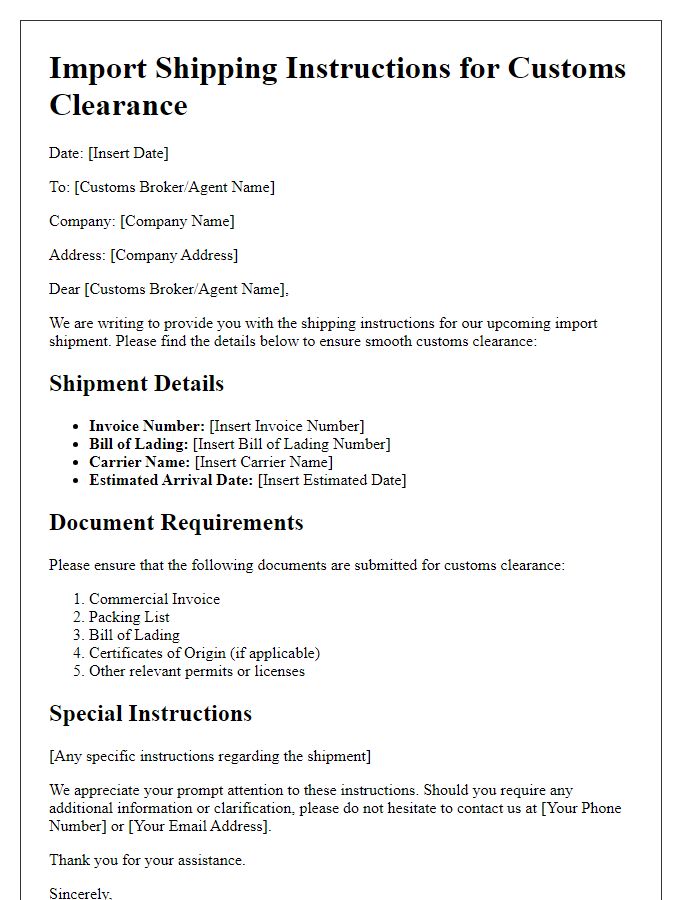Are you navigating the complexities of import shipping? Understanding the nuances of shipping instructions can make the process smoother and more efficient. In this article, we'll break down essential components of an import shipping letter, ensuring you have all the necessary information at your fingertips. So, if you're ready to simplify your shipping experience, keep reading!

Clear identification of the consignee and shipper details.
Clear identification of the consignee (recipient of the goods) and shipper (sender of the goods) is crucial for successful import shipping. The consignee's details must include the full name, address, email, and phone number to ensure accurate delivery. For international shipments, including the consignee's tax identification number (such as VAT or EIN) can expedite customs clearance. The shipper's details should also encompass the company name, complete address, contact information, and any associated trade licenses. Proper documentation prevents delays at customs facilities, such as those located at major shipping ports like Los Angeles or Rotterdam, and ensures compliance with international trade regulations. Including these elements in the shipping instructions minimizes the risk of misdelivery or customs penalties.
Precise description of goods, including quantity and packaging.
Accurate import shipping instructions are crucial for seamless logistics operations. A detailed description of goods includes specifications such as the type of product, for instance, electronic components, consumer goods, or raw materials. Clearly state the quantity, such as 500 units or 2 pallets, to ensure proper inventory management. Packaging information is also essential, including dimensions, weight (e.g., each carton weighs 10 kilograms), and packaging type (such as cardboard boxes or plastic crates) to facilitate handling and transport. Additional details like the country of origin, HS codes (Harmonized System codes), and special handling instructions, such as fragile or temperature-sensitive, can significantly enhance the shipping process and compliance with international shipping regulations.
Comprehensive instructions for the type of shipping method and preferred carrier.
Import shipping instructions detail the necessary steps for successful transportation of goods across international borders. Sea freight (often the most economical option for large volumes) is commonly preferred for bulky shipments, while air freight (known for its speed) suits urgent deliveries. Carriers like DHL, FedEx, or UPS provide various services, each with distinct tracking capabilities and delivery timeframes tailored for specific regions. Customs documentation, including the commercial invoice and bill of lading, must accompany shipments to ensure compliance with regulations in the destination country. Additionally, considerations for cargo insurance and packaging standards (to withstand rough handling during transit) are crucial for protecting the shipment's integrity. Clear communication with the chosen carrier is essential for resolving any potential logistical issues during shipping.
Detailed customs documentation requirements and compliance information.
Import shipping compliance requires meticulous attention to customs documentation, crucial for seamless international trade. Key documents include the Bill of Lading, which acts as proof of shipment and ownership, and the Commercial Invoice detailing item descriptions (HS codes), quantities, and values for customs valuation at ports like Los Angeles and Rotterdam. Certificate of Origin validates the source country, ensuring adherence to trade agreements such as NAFTA or EU regulations, preventing legal disputes. Import permits, specific to regulated goods like pharmaceuticals or food items, are essential for compliance with national regulations. In addition, accurate Harmonized Code classification facilitates tariff calculation, avoiding costly penalties. Fulfilling these requirements expedites processing through customs, preventing delays in delivery and ensuring smooth logistics across global supply chains.
Contact information for tracking and communication during transit.
Import shipping instructions require clear contact information for tracking packages and ensuring effective communication throughout the transit process. Include detailed email addresses (e.g., logistics@company.com) and phone numbers (such as +1-555-123-4567) for the shipping department. Specify the name of the freight forwarder or logistics provider, such as DHL Express, to facilitate smooth coordination. It is essential to provide alternative contacts for unforeseen circumstances, including backup contacts and their respective details. Highlight the importance of immediate updates regarding shipment status, customs clearance issues, or delivery delays, ensuring all parties are informed in real-time.













Comments